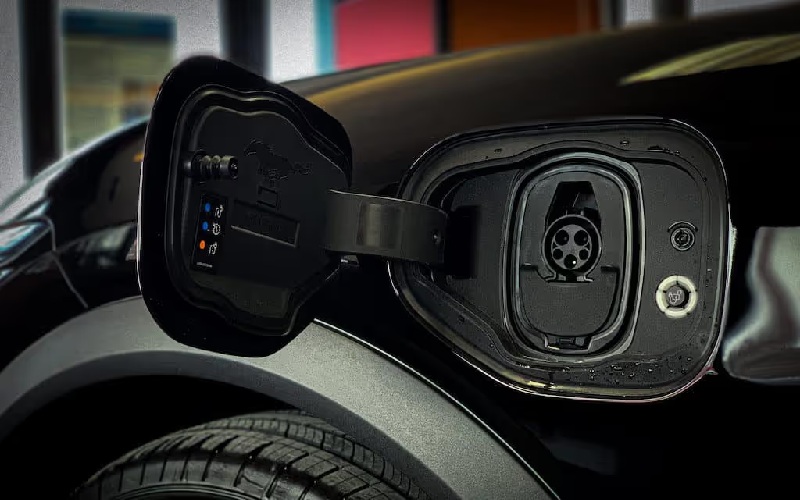2025 Ford Mustang EcoBoost Premium: A Modern Four-Cylinder
The Ford Mustang EcoBoost Premium represents the continued evolution of the Ford commitment to balancing performance and efficiency in its iconic pony car. At the heart of this model lies a sophisticated turbocharged four-cylinder engine that delivers impressive power while offering better fuel economy than its V8 counterparts. Engine Specifications and Technology The latest iteration […]
The Ford Mustang EcoBoost Premium represents the continued evolution of the Ford commitment to balancing performance and efficiency in its iconic pony car. At the heart of this model lies a sophisticated turbocharged four-cylinder engine that delivers impressive power while offering better fuel economy than its V8 counterparts.

Engine Specifications and Technology
The latest iteration of the Ford 2.3-liter turbocharged four-cylinder engine powers the Mustang EcoBoost Premium engine. This powerplant has received several refinements for the latest model year to enhance both performance and efficiency:
Key Technical Specifications:
- Engine Type: 2.3-liter inline-four with single twin-scroll turbocharger
- Displacement: 2,261 cubic centimeters
- Compression Ratio: 10.0:1
- Bore x Stroke: 87.5 mm x 94.0 mm
- Power Output: 235 kW (315 horsepower) at 5,500 rpm
- Torque: 475 Nm (350 lb-ft) at 3,000 rpm
- Redline: 6,500 rpm
- Fuel System: Direct injection with high-pressure fuel pump
- Turbocharger: Twin-scroll design with electronic wastegate
- Engine Block: High-strength aluminum alloy
- Cylinder Head: Aluminum with integrated exhaust manifold
- Valvetrain: DOHC, 16 valves with variable valve timing
- Cooling System: Enhanced with additional cooling capacity for track use
The latest model incorporates several technological advancements over previous generations. The enhanced twin-scroll turbocharger features improved aerodynamics, reducing turbo lag while maintaining efficient operation across the rev range. Ford engineers have implemented a revised cylinder head design that optimizes exhaust gas flow and improves thermal efficiency.
An updated direct injection system increases fuel atomization precision, contributing to more efficient combustion. This system is complemented by a higher-capacity intercooler that maintains lower intake temperatures even under sustained high-load conditions, preserving power output during extended spirited driving sessions.
Performance Characteristics
The EcoBoost Premium’s four-cylinder might be modest in cylinder count compared to the traditional Mustang V8, but its performance credentials remain impressive:
- 0-100 km/h Acceleration: 5.1 seconds (with 10-speed automatic)
- Top Speed: 250 km/h (electronically limited)
- Quarter-Mile Time: 13.7 seconds at 165 km/h
- Braking (100-0 km/h): 34.7 meters
- Power-to-Weight Ratio: 155 kW per tonne
These figures highlight the efficiency of modern turbocharged technology, extracting V8-rivalling performance from half the cylinders. The engine’s torque curve is particularly noteworthy, with 90% of peak torque available from just 2,000 rpm through 5,500 rpm, providing responsive acceleration in virtually any driving situation.
The new model benefits from a retuned engine control unit (ECU) that optimizes boost pressure and fuel delivery across the rev range. This calibration improves throttle response and torque delivery, particularly in the mid-range where drivers most frequently operate.
Fuel Consumption Analysis
One of the EcoBoost Premium primary advantages is its fuel efficiency relative to its performance capabilities. The latest model demonstrates impressive consumption figures across various driving scenarios:
Urban Driving (City Conditions):
- Stop-and-Go Traffic: 10.8 liters/100 km
- Moderate City Driving (50 km/h average): 9.4 liters/100 km
- Urban Highway (80 km/h with occasional stops): 8.2 liters/100 km
The engine’s direct injection and turbocharging technology shine in urban environments, where the auto start-stop system further reduces consumption during frequent stops. The turbocharger’s twin-scroll design maintains good throttle response even in lower-speed city driving, minimizing the need for downshifts and higher rpm operation.
Highway Cruising:
- 100 km/h Constant Speed: 6.9 liters/100 km
- 120 km/h Constant Speed: 7.8 liters/100 km
- 130 km/h Constant Speed: 8.5 liters/100 km
The EcoBoost engine enters its efficiency sweet spot on highways, particularly when paired with the 10-speed automatic transmission. At these speeds, the transmission typically operates in its higher gears (9th or 10th), keeping engine speeds low (approximately 1,800-2,200 rpm) while the turbocharger provides just enough boost to maintain momentum efficiently.
Mixed Driving Scenarios:
- Combined Urban/Highway: 8.4 liters/100 km
- Mountainous Terrain (varying speeds): 9.1 liters/100 km
- Aggressive Driving (higher rpm usage): 12.3 liters/100 km
The engine demonstrates good adaptability across varied driving conditions. During normal mixed driving cycles, the consumption remains competitive with much less powerful vehicles. However, aggressive driving with frequent acceleration and higher-rpm operation can increase consumption considerably, as the turbocharger requires additional fuel under boost conditions.
Performance Driving:
- Track Usage: 15.8-18.2 liters/100 km
- Sustained High-Speed Running (180+ km/h): 13.1 liters/100 km
When pushed to its performance limits on track or during sustained high-speed running, consumption increases significantly as expected. The direct injection system works overtime to supply adequate fuel for the turbocharger operating at peak boost. Ford has incorporated a more efficient cooling system to maintain optimal operating temperatures during these high-demand scenarios.
Environmental Impact Factors:
- Cold Start Impact: +25% consumption for first 5 km
- Ambient Temperature Effect: -15°C increases consumption by approximately 12%
- Tire Pressure Effect: Under-inflation by 0.5 bar can increase consumption by 4%
Environmental and maintenance factors play a significant role in real-world efficiency. The latest model incorporates faster catalyst warm-up technology to minimize the fuel economy penalty during cold starts, which is critical in colder climates.
Transmission System
The Mustang EcoBoost Premium offers two transmission options, both extensively reengineered for the latest model year:
10-Speed SelectShift Automatic Transmission:
- Gear Ratios:
- 1st: 4.696:1
- 2nd: 2.985:1
- 3rd: 2.146:1
- 4th: 1.769:1
- 5th: 1.520:1
- 6th: 1.275:1
- 7th: 1.000:1
- 8th: 0.854:1
- 9th: 0.689:1
- 10th: 0.636:1
- Reverse: 4.866:1
- Final Drive: 3.55:1
- Key Features:
- Adaptive shift scheduling using real-time driving data
- Sport mode with enhanced response and higher shift points
- Paddle shifters for manual gear selection
- Track mode calibration for performance driving
- Downshift rev-matching for smoother transitions
- Enhanced torque converter lock-up strategy
- Integrated transmission cooling system
The 10-speed automatic represents the most popular choice among EcoBoost Premium buyers. Ford engineers have implemented revised shift mapping that provides faster response times and more intuitive gear selection based on driving conditions. The transmission’s wide ratio spread contributes significantly to the vehicle’s fuel economy potential, allowing the engine to operate at optimal rpm for efficiency during cruising while providing close-ratio gearing for performance driving.
The transmission’s controller uses adaptive learning algorithms that adjust shift patterns based on individual driving style. In normal mode, it prioritizes efficiency with early upshifts and reluctance to downshift unless necessary. In Sport mode, the system holds gears longer, downshifts more aggressively, and responds more quickly to throttle inputs for a more engaging driving experience at the expense of some fuel efficiency.
6-Speed TREMEC Manual Transmission:
- Gear Ratios:
- 1st: 3.64:1
- 2nd: 2.19:1
- 3rd: 1.41:1
- 4th: 1.00:1
- 5th: 0.80:1
- 6th: 0.63:1
- Reverse: 3.28:1
- Final Drive: 3.55:1
- Key Features:
- Short-throw shifter with revised linkage
- Dual-mass flywheel for reduced noise and vibration
- Self-adjusting clutch with reduced pedal effort
- Revised synchronizers for smoother shifts
- Twin-disc clutch design
- Reinforced bell housing
The manual transmission option provides a more engaging driving experience for enthusiasts. The Ford Mustang EcoBoost Premium features a revised shift linkage that provides more precise gear selection with shorter throws between gates. The clutch offers better feel and reduced effort, addressing criticisms of earlier models.
Fuel economy with the manual transmission typically lags behind the automatic by approximately 0.5-0.8 liters/100 km in combined driving, largely due to the fewer available ratios and the human factor in shift timing. However, this gap can be narrowed considerably in the hands of a skilled driver who understands optimal shift points for efficiency.
Driving Modes and Their Effect on Engine Performance
The Ford Mustang EcoBoost Premium features the Ford Drive Mode system that significantly alters engine and transmission behaviour:
Normal Mode:
- Standard throttle response
- Early upshifts (automatic transmission)
- Default steering effort
- Fuel consumption optimized for daily driving
Sport Mode:
- Enhanced throttle response with revised mapping
- Delayed upshifts and quicker downshifts
- Increased steering effort
- Fuel consumption typically increases by 10-15%
Track Mode:
- Maximum throttle response
- Aggressive shift patterns holding gears to redline
- Performance-oriented stability control settings
- Fuel consumption increases by 25-35% over Normal mode
Drag Strip Mode:
- Specialized launch control calibration
- Optimized for straight-line acceleration
- Hold gears longer for maximum acceleration
- Typically, the least efficient mode for fuel consumption
Snow/Wet Mode:
- Reduced throttle sensitivity
- Earlier upshifts to minimize wheelspin
- Enhanced traction control intervention
- Slight efficiency benefit in adverse conditions
Each mode presents distinct fuel economy characteristics, with Normal mode prioritizing efficiency and the performance-oriented modes sacrificing economy for responsiveness and power.
Technological Innovations for Efficiency
The Ford Mustang EcoBoost Premium incorporates several technological innovations specifically targeting fuel efficiency:
Active Grille Shutters:
Electronically controlled vanes in the front grille close at higher speeds to improve aerodynamics, reducing the coefficient of drag from 0.34 to 0.32 when activated. This system can improve highway fuel economy by approximately 2-3%.
Cylinder Deactivation:
Under light load conditions, the engine can deactivate two cylinders, effectively operating as a 1.1-liter two-cylinder. This system can reduce fuel consumption by up to 8% during steady highway cruising.
Integrated Exhaust Manifold:
The cylinder head features an integrated exhaust manifold that improves thermal efficiency, reducing warmup time and overall efficiency, particularly during cold starts.
Enhanced Oil Cooling System:
A revised oil cooling system maintains optimal operating temperature even under challenging conditions, preventing oil degradation and maintaining efficient engine operation during extended high-performance driving.
Maintenance Considerations for Optimal Efficiency
To maintain the engine’s efficiency throughout its lifespan, Ford recommends:
- Premium unleaded fuel (95 RON minimum, 98 RON recommended)
- Oil changes every 12,000 kilometers or annually, using synthetic 5W-30
- Air filter replacement every 24,000 kilometers
- Spark plug replacement at 60,000 kilometers
- Regular inspection of the turbocharger and intercooler system
- Maintaining proper tire pressures (2.4 bar front, 2.2 bar rear)
Following these maintenance guidelines ensures the EcoBoost engine continues to deliver its designed balance of performance and efficiency throughout its operational life.
2025 Ford Mustang EcoBoost Premium
The Ford Mustang EcoBoost Premium’s engine represents a compelling demonstration of modern turbocharged technology. Its ability to deliver impressive performance metrics while maintaining reasonable fuel efficiency showcases the potential of smaller-displacement forced-induction engines in performance applications.
The extensive engineering refinements for the Ford Mustang EcoBoost Premium have enhanced the engine’s performance and efficiency across various driving conditions. The package delivers a driving experience that balances the Mustang performance heritage with modern efficiency expectations when paired with its sophisticated transmission options.
For drivers seeking the iconic Mustang experience with enhanced fuel economy potential, the EcoBoost Premium provides a compelling option without compromising the responsiveness and engagement that define the Mustang driving experience.



